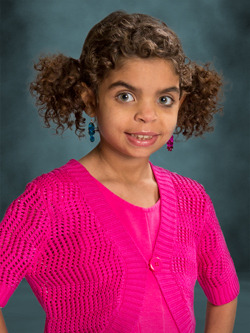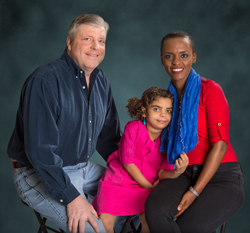Miracle Kid: Laila Streb
Who Needs Kidneys Anyway?
 Laila Streb’s body was holding so much water, she couldn’t get herself off the couch. Her parents had to carry her up the stairs at night because she couldn’t walk.
Laila Streb’s body was holding so much water, she couldn’t get herself off the couch. Her parents had to carry her up the stairs at night because she couldn’t walk.
“We didn’t even know what her face really looked like because she was so puffy for so long,” said Eric Streb, her father.
Laila, then 7, had been fighting kidney disease – a form of nephrotic syndrome called focal segmental glomerulosclerosis (FSGS) – since she was 22 months old. The fight in Laila, usually a sassy little lady, was waning.
“That’s when it begins to really rub you raw… When she began to slip, that’s when it gets to you,” said Athesia Streb, her mother.
For five years, Ayesa Mian, M.D., a pediatric nephrologist at UR Medicine’s Golisano Children’s Hospital, worked with the family to keep Laila from reaching end stage renal disease. FSGS damages the filtering units inside the kidneys, and as a result, they lose a lot of protein. To prevent further damage to her kidneys and stave off the need for dialysis, Laila was treated with several medications, including steroids.

Unfortunately, the steroids that work for many kids who develop nephrotic syndrome didn’t work as well for Laila. A cocktail of other immunosuppressive medications commonly used to treat transplant patients helped Laila for a while. But after five years of walking a tightrope between taking enough medication to help without causing her harm, the benefits were shrinking and the drawbacks were growing.
Laila was experiencing such massive amounts of protein loss in her urine that she started to retain fluid and became very puffy. The protein loss also made her more susceptible to serious infections and blood clots. By January 2014, her infection susceptibility increased and over the next few months, she was admitted to the Pediatric Intensive Care Unit several times.
Laila’s veins had become tired, making IV access difficult, so she had a central line IV catheter placed into her chest. In less than two months, she developed a large clot surrounding the central line inside her heart. Usually, a common blood thinner is used to dissolve the clot, but because Laila’s kidneys were spilling a protein needed to make the blood thinner work, she required a more complicated medication. It was becoming clear that nothing could be simple for Laila.

At the same time, Mian and the family were weighing whether it was time to remove Laila’s kidneys. Although her kidneys were still doing some work to keep her blood clean, they seemed to be causing more harm than good, placing her at risk for severe, potentially life-threatening complications.
Mian said that’s when she saw a real change in Laila. The feisty little girl who would routinely hiss at nurses when she wasn’t feeling well didn’t seem to have much fight left in her.
“That’s when she wasn’t Laila anymore,” Mian said.
The blood clot, the need for blood thinners, and the large amount of fluid she had accumulated in her abdomen meant that surgery to remove her kidneys was not an option. Instead, she frequently spent hours in the pediatric outpatient treatment center receiving infusions to help replace proteins being lost in her urine. Though the infusions seemed to help initially, their effectiveness decreased with time.
After two months, the blood clot shrank, allowing her central line catheter to be exchanged for a larger, hemodialysis catheter. Hemodialysis is a time-consuming procedure which uses a machine to clean blood and remove extra fluid. Because of how young and complicated Laila was, hemodialysis had to be performed in the children’s hospital. The Strebs had been fighting to avoid dialysis for many years, but it brought them some unexpected benefits.
“We truly didn’t know what she looked like until she started ‘hemo,’” Athesia said. Although it meant spending a day in the hospital several times a week, Laila was coming back to her family after her treatments.
Last fall, just as Laila and her family were getting accustomed to their new routine, Laila developed an abnormality in her white blood cell counts which can indicate cancer. The immunosuppressant medications used to treat her nephrotic syndrome increased her risk for developing a malignancy. Her counts were monitored closely and she underwent a bone marrow biopsy to ensure she had not developed leukemia. When the results came back negative but the counts stayed high, Suzie Noronha, M.D., a pediatric hematologist/oncologist at Golisano Children’s Hospital, worked with experts at the National Institutes of Health to make sure nothing was missed. Gradually, the counts came down.
Even after starting hemodialysis, Laila’s kidneys continued to leak protein. Because surgically removing her kidneys was still not an option yet, Mian attempted a medical nephrectomy by starting her on medication to shut down her kidneys. Unfortunately, even after several months, it didn’t work. However, hemodialysis did work and the extra fluid in her belly was gone. She was finally able to undergo surgery to remove her kidneys and place a peritoneal dialysis catheter.
Laila’s parents, Athesia and Eric, knew the transition to life without kidneys or urine could be difficult, so they redecorated Laila’s room in their Brighton home. Laila had spent so much time in the hospital over the years that, at times, they would slip up and call the hospital “home.” They hoped to spend more time in their home after Laila’s surgery, when she could switch to peritoneal dialysis. Peritoneal dialysis can be done at night while Laila sleeps in her own bed in her home.
The Strebs are just getting used to their new normal, with all their children under their own roof – big sister Afa, little brothers Ben and Sam, and Laila. They know that dialysis is not the end of their medical journey, but Laila’s experience has taught them that they need to live in the moment.
“You can be happy in the moment,” Athesia said. “You don’t have to wait for it to be all fixed.”
Down the road, Laila will go on the transplant list for a kidney, but even after she gets a new kidney, she could redevelop FSGS.
“It’s even more reason to live in the moment and ride out peritoneal dialysis as long as we can.”